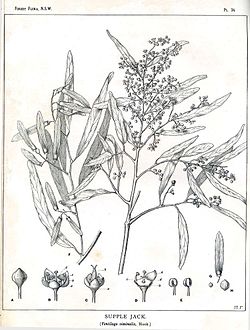| Ventilago | |
|---|---|
 | |
| Ventilago viminalis | |
| Scientific classification | |
| Kingdom: | Plantae |
| Clade: | Tracheophytes |
| Clade: | Angiosperms |
| Clade: | Eudicots |
| Clade: | Rosids |
| Order: | Rosales |
| Family: | Rhamnaceae |
| Tribe: | Ventilagineae |
| Genus: | Ventilago Gaertn. [1] |
| Species | |
See text | |
| Synonyms [1] | |
| |

Ventilago is a genus of plants in the family Rhamnaceae. It includes about 40 species found in the tropics of South and SE Asia, Australasia, with one species each in Africa and Madagascar. [2]
Plants in this genus are evergreen vines, scandent shrubs, or (rarely) small trees. Inflorescences emerge from the leaf axils and may consist of solitary flowers or glomerules . Petals are absent in some species, e.g. Ventilago ecorollata . The fruit is a single-seeded samara with a wing attached at the apex. [2]
The roots of Ventilago neocaledonica are used in Vanuatu to produce a crimson red dye (known in some local languages as labwa[ what language is this? ] or labwe[ what language is this? ] which is used to pattern traditional textiles.[ citation needed ]